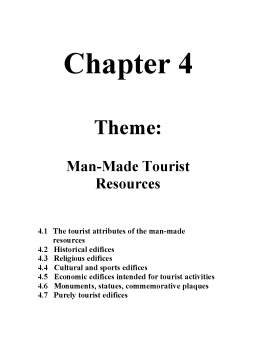Cuprins
- Theme:
- Man-Made Tourist Resources
- 4.1 The tourist attributes of the man-made resources
- 4.2 Historical edifices
- 4.3 Religious edifices
- 4.4 Cultural and sports edifices
- 4.5 Economic edifices intended for tourist activities
- 4.6 Monuments, statues, commemorative plaques
- 4.7 Purely tourist edifices
- 4.1 The tourist attributes of the man-made resources
- • Antiquity (tourist object’s age);
- • Uniqueness;
- • Novelty;
- • Dimension;
- • Present and past functions.
- 4.2 Historical edifices
- Key Words:
- Castrums; forts; castles; palaces; citadels; fortifications.
- Learning Objectives:
- O1. Castrums
- O2. Forts
- O3. Castles
- O4. Palaces
- O5. Citadels
- O6. Fortifications
Extras din curs
O1. Castrums
Historical edifices represent constructions of a remote past spread especially in the regions where great civilizations emerged.
The group of historical edifices contains: castrums; forts; castles; palaces; citadels; fortifications.
The Latin word castra, with its singular castrum, was used by the ancient Romans to mean buildings or plots of land reserved to or constructed for use as a military defensive position. As the word appears in both Oscan and Umbrian (dialects of Italic) as well as in Latin, it probably descended from Indo-European to Italic. In classical Latin the word castra always means great legionary encampment, both marching, temporary ones and the fortified permanent ones, while the diminutive form castellum was used for the smaller forts, which were usually, but not always, occupied by the auxiliary units and used as logistic bases for the legions, as explained by Vegetius. A generic term is praesidium ("guard post or garrison"). The terms stratopedon ("army camp") and phrourion ("fort") were used by Greek language authors, in order to designate the Roman castra and the Roman castellum respectively. In English, the terms Roman Fortress, Roman Fort and Roman Camp are commonly used for the castra. However the scholars' convention always wants the use of the word Camp, Marching Camp and Fortress as a translation of castra and the use of the word Fort as a translation of castellum and this type of convention is usually followed and found in all the scholarly works.[4]
O2. Forts
Forts in modern usage often refer to space set aside by governments for a permanent military facility; these often do not have any actual fortifications, and can have specializations (military barracks, administration, medical facilities, or intelligence). In the United States usage, forts specifically refer to Army fortifications; Marine Corps fortifications are referred to as camps.
However there are some modern fortifications that are referred to as forts. These are typically small semi permanent fortifications. In urban combat they are built by upgrading existing structures such as houses or public buildings. In field warfare they are often log, sandbag or gabion type construction.
Such forts are typically only used in low level conflict, e.g., counterinsurgency conflicts or very low level conventional conflicts, e.g., the Indonesia–Malaysia confrontation saw the use of log forts for use by forward platoons and companies. The reason for this is that static above ground forts can not survive modern direct or indirect fire weapons larger than mortars, RPGs and small arms.
O3. Castles
A castle (from Latin castellum) is a type of fortified structure built in Europe and the Middle East during the Middle Ages. Scholars debate the scope of the word castle, but usually consider it to be the private fortified residence of a lord or noble. This is distinct from a fortress, which was not a home, and from a fortified town, which was a public defence. The term has been popularly applied to structures as diverse as hill forts and country houses. Over the approximately 900 years that castles were built they took on a great many forms with many different features, although some, such as curtain walls and arrowslits, were commonplace.
A European innovation, castles originated in the 9th and 10th centuries, after the fall of the Carolingian Empire resulted in its territory being divided among individual lords and princes. Castles controlled the area immediately surrounding them, and were both offensive and defensive structures; they provided a base from which raids could be launched as well as protection from enemies. Although their military origins are often emphasised in castle studies, the structures also served as centres of administration and symbols of power. Urban castles were used to control the local populace and important travel routes, and rural castles were often situated near architectural and natural features that were integral to life in the community, such as mills and fertile land.
Preview document
Conținut arhivă zip
- Man-Made Tourist Resources.doc









































